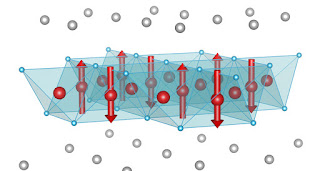 |
Magnetic order in (Sr,Na)Fe2As2: The crystal structure contains planes of iron atoms (shown as red spheres). Half the iron sites have a magnetization (shown as red arrows), which points either up or down, but the other half have zero magnetization. This shows that the magnetism results from the constructive and destructive interference of two magnetization waves, a clear sign that the magnetic electrons are itinerant, which means they are not confined to a single site. The same electrons are responsible for the superconductivity at lower temperature.
Topics: Condensed Matter Physics, Materials Science, Superconductors
A research team led by the U.S. Department of Energy's (DOE's) Argonne National Laboratory has discovered that only half the atoms in some iron-based superconductors are magnetic, providing a conclusive demonstration of the wave-like properties of metallic magnetism in these materials.
The discovery allows for a clearer understanding of the magnetism in some compounds of iron, the iron arsenides, and how it helps induce superconductivity, the resistance-free flow of electrical current through a solid-state material, which occurs at temperatures up to 138 degrees Kelvin, or minus -135 degrees Celsius.
"In order to be able to design novel superconducting materials, one must understand what causes superconductivity," said Argonne senior physicist Raymond Osborn, one of the project's lead researchers. "Understanding the origin of magnetism is a first vital step toward obtaining an understanding of what makes these materials superconducting. Given the similarity to other materials, such as the copper-based superconductors, our goal was to improve our understanding of high-temperature superconductivity."
Argonne National Laboratory:
New magnetism research brings high-temp superconductivity applications closer
Angela Hardin
Comments